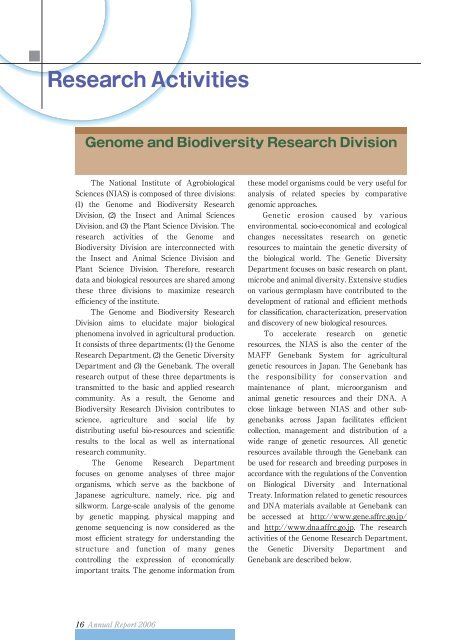Annual Report 2006
Annual Report 2006
Annual Report 2006
You also want an ePaper? Increase the reach of your titles
YUMPU automatically turns print PDFs into web optimized ePapers that Google loves.
Research Activities<br />
Genome and Biodiversity Research Division<br />
The National Institute of Agrobiological<br />
Sciences (NIAS) is composed of three divisions:<br />
(1) the Genome and Biodiversity Research<br />
Division, (2) the Insect and Animal Sciences<br />
Division, and (3) the Plant Science Division. The<br />
research activities of the Genome and<br />
Biodiversity Division are interconnected with<br />
the Insect and Animal Science Division and<br />
Plant Science Division. Therefore, research<br />
data and biological resources are shared among<br />
these three divisions to maximize research<br />
efficiency of the institute.<br />
The Genome and Biodiversity Research<br />
Division aims to elucidate major biological<br />
phenomena involved in agricultural production.<br />
It consists of three departments: (1) the Genome<br />
Research Department, (2) the Genetic Diversity<br />
Department and (3) the Genebank. The overall<br />
research output of these three departments is<br />
transmitted to the basic and applied research<br />
community. As a result, the Genome and<br />
Biodiversity Research Division contributes to<br />
science, agriculture and social life by<br />
distributing useful bio-resources and scientific<br />
results to the local as well as international<br />
research community.<br />
The Genome Research Department<br />
focuses on genome analyses of three major<br />
organisms, which serve as the backbone of<br />
Japanese agriculture, namely, rice, pig and<br />
silkworm. Large-scale analysis of the genome<br />
by genetic mapping, physical mapping and<br />
genome sequencing is now considered as the<br />
most efficient strategy for understanding the<br />
structure and function of many genes<br />
controlling the expression of economically<br />
important traits. The genome information from<br />
these model organisms could be very useful for<br />
analysis of related species by comparative<br />
genomic approaches.<br />
Genetic erosion caused by various<br />
environmental, socio-economical and ecological<br />
changes necessitates research on genetic<br />
resources to maintain the genetic diversity of<br />
the biological world. The Genetic Diversity<br />
Department focuses on basic research on plant,<br />
microbe and animal diversity. Extensive studies<br />
on various germplasm have contributed to the<br />
development of rational and efficient methods<br />
for classification, characterization, preservation<br />
and discovery of new biological resources.<br />
To accelerate research on genetic<br />
resources, the NIAS is also the center of the<br />
MAFF Genebank System for agricultural<br />
genetic resources in Japan. The Genebank has<br />
the responsibility for conservation and<br />
maintenance of plant, microorganism and<br />
animal genetic resources and their DNA. A<br />
close linkage between NIAS and other subgenebanks<br />
across Japan facilitates efficient<br />
collection, management and distribution of a<br />
wide range of genetic resources. All genetic<br />
resources available through the Genebank can<br />
be used for research and breeding purposes in<br />
accordance with the regulations of the Convention<br />
on Biological Diversity and International<br />
Treaty. Information related to genetic resources<br />
and DNA materials available at Genebank can<br />
be accessed at http://www.gene.affrc.go.jp/<br />
and http://www.dna.affrc.go.jp. The research<br />
activities of the Genome Research Department,<br />
the Genetic Diversity Department and<br />
Genebank are described below.













